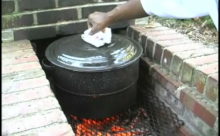Frogmore Stew Transcript
- [Narrator] As you travel through the south one state has a mind of its own South Carolina. When you cross the state line from Georgia or North Carolina into South Carolina everything changes, including the stew making. What you find instead of Brunswick stew is hash chicken bog and low country boil or Frogmore stew as it's sometimes called.
- Okay, I'm Willie Faulkner.
- How you doing?
- Okay, just go on in. They're in there.
- All right, thank you.
- Low country people are the ones who've always done this.
- Everyone have their own secret ingredients.
- [Dennis] We just got some seasonings here, you know some lemons and some celery. All the ingredients being fresh.
- Those relatives coming from the north they love ball shrimp, a lot.
- [Dennis] Corn here and some nice, fresh, white potatoes that usually adds a better flavor.
- And the last thing we will add will be the shrimp.
- Nice and delicious from the little country. And so, we're gonna add all these ingredients. And of course, the potatoes usually take the longest cause you don't add the shrimp first as Ms. Smalls was saying because you don't want them to get mushy. You want them to be, you know nice and a good consistency and succulent.
- We fix a lot of shrimp and okra. Shrimp gumbo. Many people like it hot.
- [Interviewer] When you say hot.
- [Ms. Smalls] With red pepper.
- [Interviewer] Ah, yes.
- I'm not measuring this because we just want it to be a nice, good, seasoned pot. Potatoes first, since they take the longest to cook. So what we're gonna do now is let those potatoes cook a little bit.
- The amazing thing about this too is that it has not changed the ingredients over the years. It's still a basic same five ingredients crab, shrimp, sausage, potatoes and corn. What has been left out in recent years because of the labor involved in cleaning them has been the crab but it still is the same methodology as before. Each ingredient still has its own distinct flavor. It adds something to the pot but does not lose its own identity. Cause each one of these items, if you look at it adds color and texture and a different shape actual form to the stew itself. It's a, it's one of the most beautiful dishes that you can find when it's cooked properly.
- I would always tell someone, I said you would never go hungry if you live around here because the creeks, the hunting ground, so much food even food that were grown on farms were shared in the community. Foods were an abundance.
- And we have fish stews and anything seafood we basically cooked. We even have turtle, we have Coda. My mother fixed Coda, you know, so and Coda eggs, which is a turtle, a big turtle snapping turtle.
- [Interviewer] And that's a stew?
- That's a stew also, yes.
- [Interviewer] So these are the little stews that we don't hear much about.
- No.
- But they were certainly regular fair.
- Right, right, right. Yeah, whatever you could catch, you eat, yeah.
- Okay, I think we are about ready to eat.
- After coming back to the south, I call it coming home this is absolutely the best. I'll put this stew up against any stew out there. You'll, you'll have a hard time beating it cause this is just simply a good eating. Good eating, right here.
- Like I said earlier they can put this up against any one I've tasted.
- [Interviewer] How's that Dennis?
- Coming from him, that's my verdict.
- [Ms. Smalls] I need you a master chef.
- Great, great.
